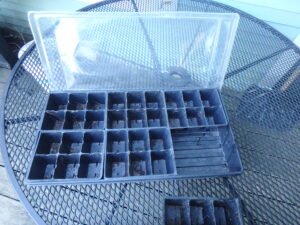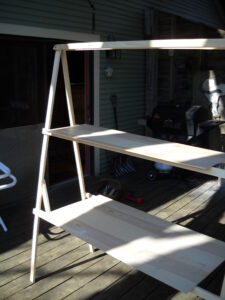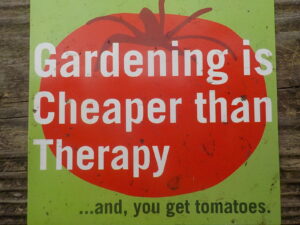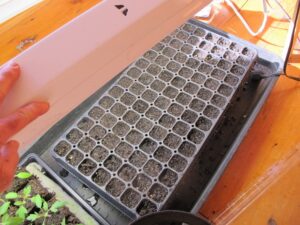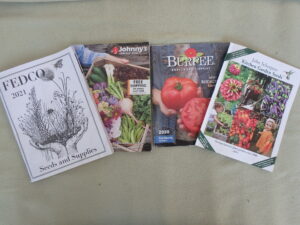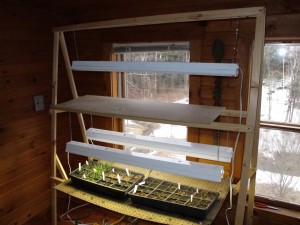Starting Seeds Indoors for a Head Start on the Season
By now many gardeners are fed up with winter: icy sidewalks, misplaced mittens, and dogs that need to go out at 5 below zero. But it will soon be time to start planting seeds indoors, so you might want to start getting ready now.
T-8 tubes use 32 watts of energy per hour, while older model T-12 tubes use 40 watts. This year I bought some LED bulbs that fit my 4-foot fluorescent fixtures but use only half the electricity. I’m switching over to LED for the sake of the environment, but as the tubes cost about $8 each, I am spreading out my purchases over a few years. If you want to make the switch, make sure the package says they do not require any re-wiring of the fixtures (older models did require that). One nice thing about the LED lights are that they don’t break if you bump them hard or drop them. Select lights that are 4000 K or 5000K color spectrum, which are close to daylight color.
Not everything needs to be started indoors. Most root crops are direct seeded in the garden, though you can start beets indoors. Some flowers hate to be transplanted – larkspur, for example, which also needs cold temperatures after planting. Lettuce can be planted indoors or out, or both. I like to get some started early indoors. All the cucumber family plants I start indoors 4-5 weeks before planting outside as this protects them from striped cucumber beetles when they first germinate.
I mostly use flats with 32-cells per trays that are roughly 9 by 18 inches, although others are sold with up to 108 cells per flat. I want plenty of room for roots to grow, so I buy cells that are as deep as I can find. I plant two or more seeds in each cell, just in case one seed does not germinate. For onions, I plant 3 or 4 seeds per cell, as they don’t mind a little crowding.
Starting from Seed
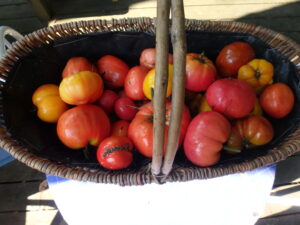
Heirloom tomatoes are often irrecular in size and shape but they are tasty and you can save seed for next year
Most seeds are good for 3 years. Of the seeds I use, onions and parsnips are just good for just one year. Peppers, parsley, corn and leeks are good for two years. Most of the cabbage family (kale, broccoli, etc.) and squash family (cukes and zukes) are good for four years. Basil and some flowers are good for five years.
It’s important to know what seeds need to be started indoors, and which can do well planted directly in the ground. All your root crops are best started outdoors in the ground, though beets can be started indoors. Beans and peas are direct seeded outside, too. Corn can be started in the ground, or indoors in flats. Crows love freshly germinated corn seeds with a little green leaf, so planting 4-inch plants started indoors is good if you have just a small plot.
I always get some things from Johnny’s Selected Seeds, an employee-owned company in Maine that is favored by commercial growers. They provide excellent growing information. This year they provide excellent comparison photos in each section – all their tomatoes, side-by-side, for example.
Renee’s Garden Seeds has great seeds – but no print catalog. Still, I order from them most years. I love their mixes of different color veggies in one pack – 3 colors of beans, or two colors of carrots.
Starting Seeds Indoors
Wind in the Willows, one of my favorite children’s books, has a great quote that came to me recently. The water rat says to his friend, the mole, “Believe me, my young friend, there is NOTHING–absolutely nothing–half so much worth doing as simply messing about in boats. Simply messing,’ he went on dreamily: `messing–about–in–boats; messing—-“. At that point he crashes into the bank and comes back to reality.
What, you might fairly ask, does that have to with gardening? Well, at this time of year I would substitute the word “seeds” for “boats”. Messing about with seeds is wonderful – for the soul, for the mind, and later –for your garden. It’s time now to start planting seeds indoors for summer vegetables.
I generally plant tomato seeds indoors around April 10, sometimes a bit sooner, for planting outdoors 8 weeks later. I have already planted onions, celeriac, a few special peppers and lots of lisianthus (an annual cutflower). Those all need more than 8 weeks. Later, 4-5 weeks before planting time in June, I will start my squash and cucumber seeds in 3-inch pots. By starting them indoors and putting out good-sized plants (they grow fast) I am able to prevent them from being eaten up by striped cucumber beetles. Those beetles can devour a freshly germinated seedling outdoors in a single night – but won’t do much to plants with 6-inch vines.
There are a couple of keys to success growing tomatoes and other seedlings indoors. Most important is having adequate light. You really cannot grow healthy seedlings by depending on sunlight on a windowsill. You need lights – either the new-fangled LED lights for plants, or T-8 fluorescent fixtures that are 4-feet long and provide good light for seedlings. You do not need those special (read expensive) “Gro-Light” bulbs with special wave lengths (equivalent to the sun) for starting seedlings.
Last year in my column I wrote directions for building a simple A-frame plant stand, so will not repeat them this year. You may find it at my web site, www.Gardening-Guy.com. Just go to the search engine box and type in plant stand. Or, if you prefer, design your own or buy a light stand from your local garden center or from Gardeners Supply (www.gardeners.com). But you do need lights to succeed.
It is also critical that seeds and the potting mix you use do not dry out, especially when the seeds are just starting to open up and send out little roots and shoots. They are particularly vulnerable then. So check your seeds every day and water as needed.
You may also get clear plastic covers to fit over your growing flats. These allow light to pass, but hold in water. Water will evaporate, then condense on these covers and rain down gently on your seedlings. You could accomplish the same effect with plastic wrap but then, as they germinated, the plants would butt heads with the wrap. The plastic covers provide an inch or two of growing space, allowing some to grow while others are still waking up.
Commercially prepared seed starting mix is largely composed of peat moss. Peat moss has no “food value” to plants. It provides a light, airy space that roots find easy to penetrate, and it holds water. Most have some fertilizer added, but this soon disappears either by washing away or being used up by the plants. So, as your plants get bigger, plan on giving them some liquid fertilizer – or they will languish.
Seaweed or fish fertilizers are readily available, and are better than chemical fertilizers – they provide a full menu of minerals, including the micronutrients important for plants. Fish fertilizers may offend some delicate noses when growing plants indoors, however.
An alternative to growing seedlings in straight potting mix is to mix it 50-50 with compost. It probably makes sense to buy compost for this even if you make your own. Why? Because commercial compost should be weed-free and your own compost probably is not. Unless you know what each seedling looks like when it first germinates, you may end up babying weeds along – or pulling out your seedlings. This can be a real problem if growing flowers that you have not grown before.
Lastly, think about planting seeds by the position of the stars and moon. I know, I know, it sounds pretty “out there”. But last year I used the Stella Natura (www.stellanatura.com) planting calendar which uses biodynamic principles to determine when to plant or transplant, and I saw real differences when I experimented with planting in the designated blackout times. Seeds are still one of life’s mysteries – all that life packaged in such a small container. Who knows what really affects them? Not me, that’s for sure.
Henry may be reached at henry.homeyer@comcast.net. His web sites are www.Gardening-guy.com and www.henryhomeyer.com.



